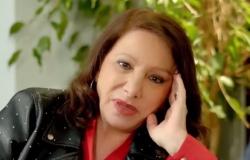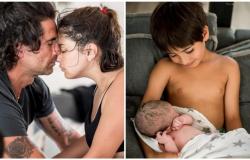
“You know that I have always been an open book, but until now I had not felt ready to say anything.” Céline Dion revealed in 2022 that she suffered from Rigid Person Syndrome, a rare autoimmune disease that affects the nervous system and that, as she explained, “one in a million people suffer from.” “We already know what has been causing the spasms that I have been having,” she explained about the symptoms that appeared in her life seventeen years ago, getting worse and determining her daily life, causing everything from problems walking to limiting her vocal cords. “I have to focus on my health,” she explained about the condition that forced her to say goodbye to the stage.
The preparation and subsequent recording of the video with which he communicated his illness is part of I’m Celine Dion, the documentary that arrives this June 25 on Amazon Prime Video, and in which the Canadian artist has opened up on the channel about what the syndrome is meaning for her. The interpreter of My Heart Will Go On and Because You Loved Me Not only has he let the cameras orchestrated by director Irene Taylor into his home, he has sat in front of them to, combined with numerous archive images that span his career, share how he feels. “The difficult thing is not to do concerts, the difficult thing is to cancel them,” she says through tears.
Dion tries to sing one of her songs at a certain moment in the film, after which she collapses because she is “embarrassed” to hear herself like that, to be heard by the film’s team and, above all, her audience. Because of how tight her voice sounds, it is at times broken and lacking body and treble. As she began to experience that her instrument was not working, they increased her medication to levels at which, as she states: “I could have died.” At the same time, the treatment became necessary for her to even “swallow.”
The singer confesses that, upon being forced to have to cancel shows, and without yet knowing what was happening to her, her first reaction was to “lie.” They made excuses like she had sinusitis, otitis or some other milder condition. “She couldn’t go on like this,” she says. “Sometimes she would bring the microphone closer to the people so they could sing, she would do tricks like hitting the microphone to make it seem like there was a technical problem. “She stopped concerts to change my clothes and never came back,” she lists guiltily.
“All I know how to do is sing,” he acknowledges, this being one of the keys to the film. Céline Dion (Canada, 1968), daughter of musician parents, found her first audience in her family, made up of thirteen other siblings. “I have never sung for myself, I always did it for them,” she remembers about her childhood and adolescence, of which images of her are shown, especially from the piano bar where she began to perform. “My dream is to be an international star and be able to sing all over the world,” she said in one of her first interviews. At the age of 12 she had already composed her first song, Ce n’etait qu’un reve (It was just a dream) and in 1981 he published his first album, The voice of bon Dieuwhich was followed Unison (1990), in English, which opened the doors of the international market, forever.
More than three decades later, he has sold more than 200 million albums worldwide, won five Grammy Awards, seven Billboard Music Awards, and received two Honorary Doctorates in Music from the prestigious Berklee College of Music and Université Laval. He also won Eurovision, in 1988, representing Switzerland with Ne partez pas sans moi. Céline Dion has one of the best voices in history, which has immortalized hits like It’s All Coming Back To You or your version of River Deep Mountain High; and precisely for this reason it is so disheartening to witness the cruelty of a syndrome that has taken away its powerful instrument.
The singer does not skimp on giving details about the condition. The first day she felt a spasm was having breakfast. “Normally when you come from having given a demanding concert or your voice is tired, your register drops half a tone or a note. But it got worse for me and that scared me,” she remembers. This caused her to have to reduce warm-up times – essential to take care of her cords and muscles, and preserve her full potential – in such a way that she began to be “scared.” And there was no turning back.
“I’m trapped”
Rigid Person Syndrome has forced Dion to have to lock himself up at home, to rest, to receive daily treatment and physiotherapy sessions with which he is making progress little by little. There she lives with her fourteen-year-old twin sons, Eddy and Nelson; and René Charles, 23. She had all three with the musician René Angélil, with whom she was married from 1994 until he died from throat cancer in 2016. His death notably affected Dion, who remembers in her documentary how broke down in his next performance, in February of that same year in Las Vegas, in which he could not finish another of his most emblematic songs, his version of the All By Myself by Eric Carmen.
Dion feels “trapped” but not alone. In addition to her family, her inseparable dog, and her team of doctors, she takes advantage of the film to praise the work of her band. “We grew up together and we became close because what we all wanted was to be the best,” she says between images of concerts featuring her musicians. “If you want to get there quickly, go alone. If you want to go far, go in company”, she defends on what she identifies as the basis of a career of more than thirty years.
He keeps some of his musicians and backup singers’ costumes in a huge warehouse that functions as his own trunk of memories, and which he visits for the film. His passion for high-heeled shoes is notable, and the stylish looks with whom he has walked countless red carpets. There are also drawings of his children, instruments, clippings, toys and a very long etcetera that, without a doubt, could open a museum.
The cruel uncertainty
“I haven’t sung for two years. I don’t know if I’ll be able to do it again, but I can’t live with the doubt,” she reveals in the second part of the documentary, in which she goes to the studio to try to record the song. love again –included in the film’s soundtrack–. A melodic ballad that says in its chorus: “You don’t have to move mountains, just keep going. Every move is a new emotion and you don’t have to find the answer, just keep trying. The sun will rise again, the storms will subside. This is not the end”.
She begins to sing the first verse, unconvinced, in falsetto, to which her companions respond: “We haven’t heard you like that in years. It is music to our ears.” In an example of her perseverance, tenacity and ability to work, despite her condition, Dion asks to repeat each phrase over and over again, simultaneously afflicting the fatigue of her vocal cords. His gesture shows helplessness, since by evoking past times in which he could record “three songs every night”, go from the lowest note to the highest in his range with little effort and, in essence, enjoying himself, he confesses that he misses “ less singing without thinking.”
“Maybe I can change my repertoire but it will be the public who will have to decide if they like it or not,” he points out. When he returns the next day, she does not like the outcome of the issue. He asks to re-record, this time achieving his goal. Immediately afterwards, she goes to see her physical therapist to proceed with her daily check-up, and the dreaded spasm appears. “It could lead to a crisis,” he warns, and he is right. In just a few minutes, the singer is lying on her side on the stretcher, unable to speak and barely making any sounds other than moans of pain. She doesn’t close her eyes, her mouth is stiff. The effect of a nasal spray is what finally allows her muscles to relax. The only way for her to communicate with her is by squeezing her doctor’s hand with her fingers.
“Do you want us to turn off the cameras?” they ask her when she is somewhat more stabilized. She says no, making visible the tentacles of her illness. When analyzing what happened, the specialist explains that her crisis was caused by “brain overstimulation.” “Doing what I love stimulates me,” Dion shares worriedly, understanding that this could lead to not entering a studio again, as a precaution. Her doctor reassures her by indicating how important it is to continue taking steps and evaluating how to control the condition. With the singer already standing, the specialist lets her listen to the last song of the day: Who I Am Wyn Starks, with which he goes out of his way from the first note.
Recover your energy. Energies that the syndrome weakens and that the artist confronts by looking and stepping forward as hard as she can. Feeling that she is “on the path” is what allows her to do it, without stopping smiling, even if it is through tears. It is no coincidence that the documentary is called I’m Celine Dion, since it is being true to herself that allows her to continue working and trusting in her recovery. And here she has been recorded in a film that does not romanticize suffering, does not idealize the fight against the disease nor is it defeatist. It is what Dion can be at any moment. With and without makeup.





